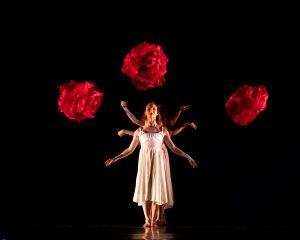There are still a few masterpieces in my musical “bucket list,” but I am happy to say that I have heard my first live performance of the Passion According to St. John (Johannes Passion) by J. S. Bach – and what an experience it was! Forget the anachronism of presenting a Passover-related text at a time when our minds are on the advent of the nativity celebration – the power of the music and the drama of the plot, regardless of one’s religious persuasion, make this work timeless and unforgettable. In our contentious era, there are those who would attribute racial or religious bias to the texts Bach chose, but pointing fingers and mincing words should never inhibit the power of the music. And Music Director Robert Moody led this powerful performance in a masterful manner.
The Winston-Salem Symphony and Chorale and Maestro Moody were joined by half a dozen superb vocal soloists for this presentation at the Stevens Center in Winston-Salem, NC. The hefty role of narrator of this biblical event is given to the Evangelist, whose high tenor part was admirably sung by John McVeigh. He has a lovely voice and precise pronunciation. The protagonist is Laurence Albert, whose warm and dark bass voice made him a touching, thoughtful and believable Jesus.
The quartet of soloists who joined McVeigh and Albert sang a variety of roles, but all were excellent! Mezzo-soprano Mary Gayle Greene was the first to sing; her warm voice blended exquisitely with the double reed trio which accompanied her. Rarely have two oboes sounded so perfectly matched – down to perfectly synchronized trills!
She was followed by soprano Kathryn Mueller whose aria is accompanied by two unison flutes and continuo. After a somewhat “pitchy” start, Ms. Mueller settled into a beautifully clear and pure voice that seemed to float effortlessly. Tenor Daniel Stein (most often Simon Peter) has a bright but warm voice which he used with intelligence and energy in all three of his arias. Sidney Outlaw (Pilate) had many interjections and conversations with the Evangelist as well as several arias which showed his powerful baritone voice to be expressive and flexible.
The reduced Baroque orchestra (19 strings) was augmented by a small electronic organ (positive), a pair of flutes, a pair of oboes, a bassoon and four instruments, already considered old-fashioned in Bach’s time, oboe da caccia (“hunting oboe,” usually replaced by an English horn), a pair of viole d’amore (violas with several sympathetic resonating strings), a lute and a viola da gamba. The names of the walk-on viola d’amore and lute players were not mentioned in the program, nor was that of the organist; all deserve recognition for jobs well done.* And special kudos to Brooks Whitehouse on cello (continuo) and Anne Sellitti for her gamba solo accompanying Ms. Mueller in the touching aria, “Es ist vollbracht” (“It is finished” – or better, “It is accomplished”), after which the Evangelist sings, with great simplicity: “And He bowed His head and died.”
A particularly ironic moment occurs next. Unexpectedly, in a major key, the singer who has sung Pilate throughout the Passion (Mr. Outlaw) asks if “now, nailed to the cross, Jesus, can your pain and death free me from fear of death” while the cello plays a gigue-like solo (in 12/8) and the chorus intones a somber chorale in the background. The contrast between the profound sadness at Jesus’ death and the upbeat (“spiccato” in the score) cello-led solo and chorale is moving.
Another remarkable passage had occurred earlier, in the opening chorale of the Part Two. While the text describes the capture of Jesus by an angry mob, the music becomes more and more dissonant, yet calmly and serenely paced, as though to illustrate the uselessness of trying to alter His destiny.
Finally, a word about the chorus, well-trained by Carole Ott, director; large by most standards for a Baroque work (84 singers), it was effective, well balanced (more tenors needed!) and very much in tune. Attacks and cut-offs (after some inattentive slips early in the concert) were clean and the diction clear. The contrast between large chorus and small chorus was pleasing and effective.
A personal source of irritation was the occasional lag in the super-titles and their suppression when the words are repeated. (I often forget to look up, being engrossed in what is happening on stage.) Perhaps when words and lines are repeated often (as in fugues and arias) several lines could be presented at once, as in a paragraph. I was also disturbed by the frequent pause before the last note of a movement, a sort of non-musical hiccough.
The concert will be performed again on Tuesday, November 22, at 7:30 p.m., also at the Stevens Center. The second half of the concert is long, so some may want to take advantage of the intermission.
*The orchestra has graciously provided the names of the guest artists: viole d’amore: Kristen Beard and Allison Willet; lute: Joseph Pecoraro; & portative organ: James Jones.











